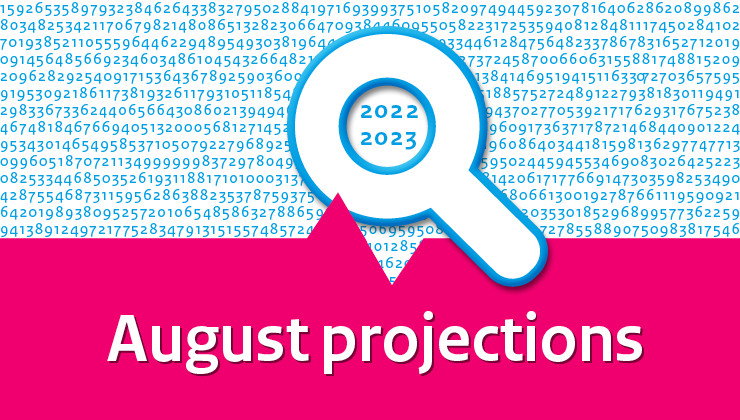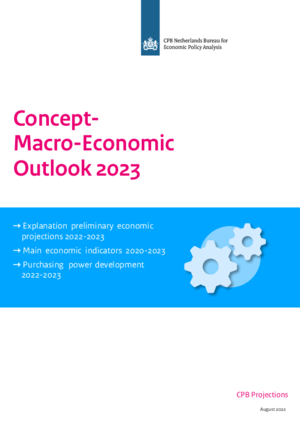Projections August 2022
Inflation is affecting more and more people, economic growth decreases

These projections form the starting point for the Dutch Cabinet’s final decision-making process regarding next year's budget. On 'Prinsjesdag' (i.e. the day of the King's Speech which includes the main elements of the government budget for the coming year, this year on 20 September), CPB will publish the definitive version of the Macro Economic Outlook (MEV), which also incorporates these latest decisions.
Purchasing power greatly reduced, while poverty increases
Wage increases are lagging behind the high rate of inflation, which is reducing average purchasing power by 6.8% in 2022. In addition, there is inflation-related inequality: the lower the income, the greater the financial burden of inflation. Standard purchasing power is based on average inflation and, therefore, does not take into account these kinds of differences between households.
This is the first year that CPB’s projections include poverty development. Poverty is increasing, as inflation means that people need more and more money to meet their basic needs, while income levels are rising only slightly. As a result, the percentage of people suffering from poverty will increase to 7.6% in 2023, and for children this is even 9.5%. As is the case with purchasing power, these figures are an underestimation of the actual problems.
| 2020 | 2021 | 2022 | 2023 | |
| Economic growth slows down after strong recovery (gdp, growth %) | -3.9 | 4.9 | 4.6 | 1.1 |
| Labor market remains tight (unemployment, % labour force) | 4.9 | 4.2 | 3.4 | 3.9 |
| Energy prices cause high inflation (cpi, %) | 1.3 | 2.7 | 9.9 | 4.3 |
| Static purchasing power reduces greatly (%) | 2.5 | 0.3 | -6.8 | 0.6 |
| Temporary factors improve government deficit (% gdp) | -3.7 | -2.6 | -0.9 | -1.1 |
Read more (extended explanation, main economic indicators, purchasing power).
Downloads
Table 'Main economic indicators', 2020-2023, August 2022
| 2020 | 2021 | 2022 | 2023 | |
| Relevant world trade volume goods and services (%) | -9.1 | 8.4 | 4.9 | 2.9 |
| Export price competitors (goods and services, non-commodities, %) | 0.3 | 6.1 | 9.7 | 3.2 |
| Crude oil price (dollar per barrel) | 41.8 | 70.7 | 105.3 | 89.7 |
| Exchange rate (dollar per euro) | 1.14 | 1.18 | 1.06 | 1.02 |
| Long-term interest rate the Netherlands (level in %) | -0.4 | -0.3 | 1.1 | 1.6 |
| 2020 | 2021 | 2022 | 2023 | |
| Gross domestic product (GDP, economic growth, %) | -3.9 | 4.9 | 4.6 | 1.1 |
| Household consumption (%) | -6.4 | 3.6 | 5.7 | -0.3 |
| Government consumption (%) | 1.6 | 5.2 | 1.6 | 3.2 |
| Capital formation including changes in stock (%) | -6.3 | 2.9 | 2.6 | 0.8 |
| Exports of goods and services (%) | -4.3 | 5.2 | 4.0 | 3.2 |
| Imports of goods and services (%) | -4.8 | 4.0 | 2.8 | 3.2 |
| 2020 | 2021 | 2022 | 2023 | |
| Price gross domestic product (%) | 1.9 | 2.5 | 4.2 | 5.4 |
| Export price goods and services (%) | -2.9 | 8.3 | 16.6 | 2.9 |
| Import price goods and services (%) | -3.6 | 10.2 | 22.1 | 2.6 |
| Inflation, national consumer price index (CPI, %) | 1.3 | 2.7 | 9.9 | 4.3 |
| Inflation, harmonised index of consumer prices (HICP, %) | 1.1 | 2.8 | 11.4 | 4.3 |
| Compensation per hour private sector (%) (a) | 7.9 | 0.1 | 2.4 | 4.3 |
| Wages as determined in collective labour agreements, private sector (%) | 2.8 | 2.2 | 2.9 | 3.4 |
| Purchasing power, static, median all households (%) | 2.5 | 0.3 | -6.8 | 0.6 |
| People in poverty (level in %)(b) | 5.7 | 6.7 | 7.6 |
| 2020 | 2021 | 2022 | 2023 | |
| Labour force (%) | 0.4 | 0.9 | 1.7 | 1.4 |
| Active labour force (%) | 0.0 | 1.5 | 2.5 | 0.9 |
| Unemployment (in thousands of persons) | 465 | 408 | 340 | 390 |
| Unemployed rate (% of the labour force) | 4.9 | 4.2 | 3.4 | 3.9 |
| Employment (hours, %) | -2.8 | 3.3 | 5.2 | 0.4 |
| 2020 | 2021 | 2022 | 2023 | |
| Labour share in enterprise income (level in %) | 76.3 | 74.5 | 75.0 | 73.8 |
| Labour productivity private sector (per hour, %) | -1.5 | 2.5 | -0.4 | 0.8 |
| Private savings (% of disposable household income) | 12.8 | 11.5 | 6.1 | 4.8 |
| Current-account balance (level in % GDP) | 7.1 | 9.0 | 7.2 | 7.4 |
| 2020 | 2021 | 2022 | 2023 | |
| General government financial balance (% GDP) | -3.7 | -2.6 | -0.9 | -1.1 |
| Gross debt general government (% GDP) | 54.7 | 52.4 | 48.8 | 47.1 |
| Taxes and social security contributions (% GDP) | 39.9 | 39.7 | 39.2 | 38.4 |
| Gross government expenditure (% GDP) | 48.2 | 47.0 | 45.6 | 44.4 |
(a) The NOW wage cost subsidy, and the continuity contribution to health care, have an upward effect on the wage mutation in 2020 of 3.3%-points and a downward effect of 2.0%-points in 2021 and 1.2%-points in 2022.
(b) The ratio of the number of persons in households below the poverty line and the total number of persons. The modest-but-adequate budget of the Social and Cultural Planning Office has been used as the poverty line.
Contacts



